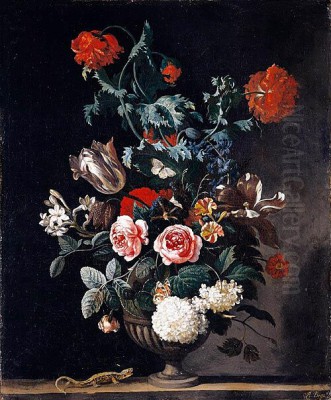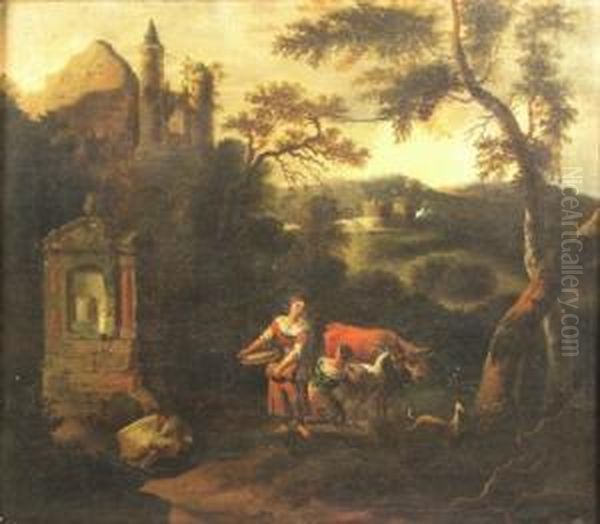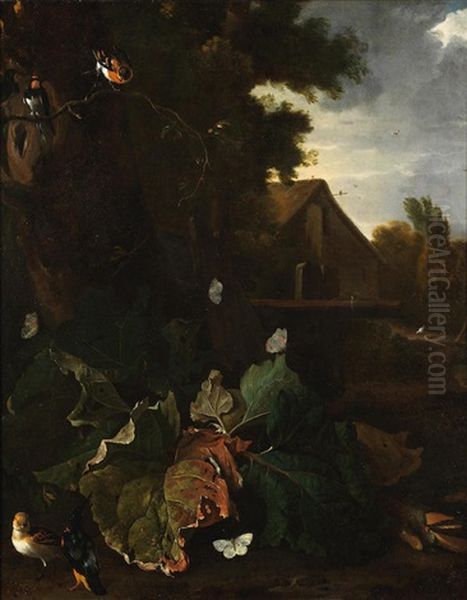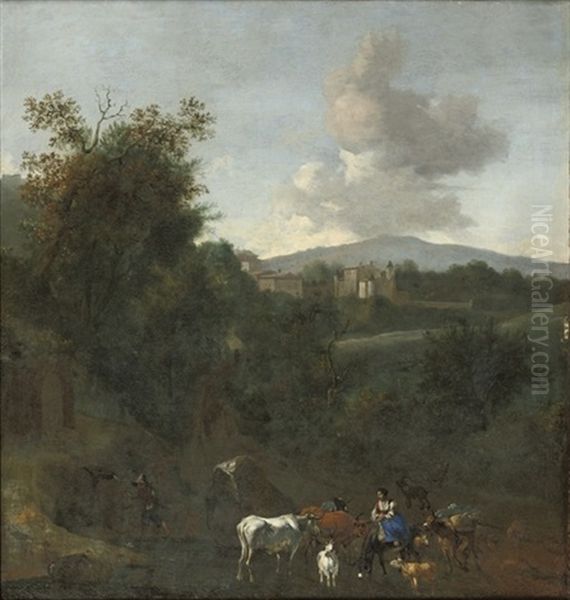
Abraham Jansz. Begeyn stands as a notable figure within the rich tapestry of the Dutch Golden Age of painting. Born in Leiden in 1637 and passing away in Berlin in 1697, Begeyn carved out a significant career as both a painter and a draughtsman. His artistic output primarily focused on landscapes, particularly those imbued with an Italianate sensibility, alongside detailed still lifes, especially of the forest floor variety, and depictions of animals within natural settings. His life and work reflect the dynamic artistic exchanges and diverse patronage systems of the 17th century.
Begeyn's journey took him from his native Netherlands to England and eventually to Germany, where he achieved the prestigious position of court painter. Throughout his active years, spanning roughly from the mid-1650s until his death, he demonstrated a remarkable ability to capture the nuances of the natural world, combined with a compositional elegance that appealed to contemporary tastes. His legacy endures through works held in major international collections and his contribution to specific genres popular during his time.
Early Life and Artistic Formation in Leiden
Abraham Begeyn entered the world in Leiden, a prominent center of learning and art in the Dutch Republic during the 17th century. The city fostered a vibrant artistic community, home to renowned masters like Rembrandt van Rijn (though Rembrandt had moved to Amsterdam by the time Begeyn was active) and the celebrated fijnschilders (fine painters) such as Gerrit Dou and Frans van Mieris the Elder. While Begeyn's style would differ significantly from the Leiden fine painters, the city's atmosphere undoubtedly provided a stimulating environment for a budding artist.

A key step in his early career occurred in 1655 when Begeyn joined the Guild of Saint Luke in Leiden. Membership in the guild was essential for artists wishing to practice professionally, take on apprentices, and sell their work within the city. It signified a formal recognition of his skills and his entry into the professional artistic ranks. He remained associated with the Leiden guild until at least 1667, indicating a substantial period of activity in his hometown. The specific details of his training remain somewhat obscure, but his stylistic affinities strongly suggest exposure to, and absorption of, prevailing trends, particularly the Italianate landscape tradition.
The Influence of the Italianate Style
One of the defining characteristics of Abraham Begeyn's landscape painting is its connection to the Italianate style. This movement saw Dutch and Flemish artists depicting scenes inspired by the Italian countryside, often characterized by warm, golden light, rolling hills, picturesque ruins, and pastoral figures like shepherds and their flocks. These artists did not always travel to Italy themselves; sometimes, they drew inspiration from the works of others who had made the journey or from prints and drawings.
Begeyn's work clearly shows the influence of Nicolaes Pietersz. Berchem, one of the most successful and prolific Dutch Italianate painters. Berchem's skillful rendering of atmospheric light, his lively depiction of figures and animals, and his idealized yet believable landscapes set a standard that Begeyn often emulated. Like Berchem, Begeyn frequently incorporated classical or medieval ruins into his compositions, adding a sense of history and romanticism. Other prominent Italianate painters whose work Begeyn would likely have known include Jan Both, Jan Asselijn, Karel Dujardin, and Adam Pynacker, all contributing to a popular genre that offered an idealized escape from the flatter landscapes of the Netherlands.
While embracing the Italianate mode, Begeyn's work often retained a distinctly Dutch sensitivity to detail and texture. He did not merely copy Italian models but adapted the style, sometimes blending it with elements more typical of native Dutch landscape painting, associated with artists like Jacob van Ruisdael or Meindert Hobbema, though Begeyn's overall mood is generally sunnier and more serene than that found in the works of Ruisdael. This fusion contributed to the unique appeal of his landscapes.
Master of Landscapes and Pastoral Scenes
Landscapes formed the core of Begeyn's oeuvre. His compositions typically feature expansive views, often framed by trees or rocky outcrops, leading the viewer's eye into the distance. Rivers, bridges, and distant mountains are common elements, bathed in the warm, often hazy light characteristic of the Italianate school. He populated these scenes with figures and, most notably, animals, which he rendered with considerable skill and attention to anatomical accuracy.

His depictions of livestock – primarily sheep, goats, and cattle – are particularly noteworthy. Works such as Golden Age Sheep and Goat in a Landscape (or similar titles describing pastoral scenes) exemplify his ability to integrate animals seamlessly into the landscape, creating harmonious and idyllic visions of rural life. These pastoral themes resonated strongly with urban Dutch audiences, offering romanticized images of nature and simplicity. His skill in animal painting invites comparison with specialists like Paulus Potter, although Begeyn usually integrated his animals more fully into broader landscape settings rather than making them the sole focus. Adriaen van de Velde, another contemporary, was also renowned for his animal painting and Italianate landscapes.
Begeyn's landscapes often include architectural elements, ranging from rustic cottages to imposing castle ruins. The inclusion of ruins, a popular motif in 17th-century art, evoked notions of the passage of time, the grandeur of the past, and the picturesque decay of man-made structures reclaimed by nature. Paintings titled Castle Ruins or similar subjects highlight this interest, aligning him with artists fascinated by history and the romantic potential of dilapidated structures.
Expertise in Still Life: The Forest Floor
Beyond landscapes, Abraham Begeyn demonstrated considerable talent in the realm of still life painting, particularly in the specialized subgenre known as sottobosco, or forest floor still life. These paintings focus on the microcosm of life found low to the ground in woodlands and marshes: fungi, thistles, wildflowers, mosses, insects, snails, lizards, snakes, and sometimes small mammals like hedgehogs.
His work Still Life Forest Floor (or variations like Forest Floor Still Life with Thistle, Flowers, and Reptiles) showcases his meticulous attention to detail and his ability to render diverse textures convincingly – the prickliness of thistles, the dampness of moss, the smooth skin of a reptile, the delicate wings of a butterfly. These compositions are often characterized by dramatic lighting, with shafts of light illuminating the foreground against a darker, shadowy background, enhancing the sense of mystery and close observation.
The sottobosco genre was pioneered and popularized by Otto Marseus van Schrieck, another Dutch artist active during the same period. Begeyn clearly worked within this tradition, contributing his own refined examples. These paintings were appreciated not only for their technical virtuosity but also potentially for their symbolic content, sometimes interpreted as reflections on nature's fecundity, the cycle of life and death (vanitas), or the intricate beauty of God's creation even in its humblest forms. Begeyn's Still life with Hedgehog and Butterflies, held in the Nationalmuseum, Stockholm, is a prime example of his skill in this intimate genre.
Travels, Patronage, and Later Career in Berlin

Begeyn's career was not confined to Leiden. Like many artists of his time, he sought opportunities elsewhere. Records suggest periods of activity in Amsterdam, the bustling commercial and artistic heart of the Netherlands. The provided information also mentions activity in England, although details about his time there, if any, are scarce and require further verification. Such travels were common for ambitious artists seeking new patrons and markets.
A significant chapter in Begeyn's later life began in 1688 when he moved to Berlin. There, he received a prestigious appointment as court painter to Frederick III, the Elector of Brandenburg, who would later become Frederick I, King in Prussia. This position marked a high point in his career, indicating considerable recognition and status. Working for the Elector likely involved producing paintings for the court's collections, decorating palaces, and possibly undertaking other artistic duties. His move to Berlin placed him in a different artistic milieu, interacting with German patrons and potentially other artists employed by the court.
His time in Berlin, however, came to a tragic end. In 1697, while working on a project, Abraham Begeyn died as a result of falling from scaffolding. This unfortunate accident cut short the career of a respected and versatile artist who had successfully navigated the art markets and patronage systems of several European centers.
Contemporaries and Artistic Context
Abraham Begeyn operated within a rich and diverse artistic landscape. His closest stylistic connection was undoubtedly with Nicolaes Berchem, whose Italianate landscapes served as a significant model. He was part of the broader movement of Dutch Italianate painters, which included Jan Both, Jan Asselijn, Adam Pynacker, and Karel Dujardin, all of whom helped shape the taste for Mediterranean scenes.
Within the specific genre of sottobosco still life, his work runs parallel to that of Otto Marseus van Schrieck. In Leiden, during his early years, he would have been aware of the dominant fijnschilder tradition led by Gerrit Dou and Frans van Mieris the Elder, even though his own style developed differently. The mention of Cornelis van Poelenburch connects him to an earlier generation of Utrecht-based Italianate painters. Adriaen van der Vaart was another contemporary landscape and figure painter.
The reference to Pieter de Hooch as an inspiration is interesting, though perhaps less direct stylistically. De Hooch was a master of genre scenes, renowned for his depictions of domestic interiors and courtyards with complex treatments of light and space. While their primary subjects differed, Begeyn might have admired De Hooch's handling of light and atmosphere, qualities important in landscape painting as well. Begeyn's work should also be seen in the context of other Dutch landscape specialists like Jacob van Ruisdael and Meindert Hobbema, who represented the "native" Dutch tradition, and animal painters like Paulus Potter and Adriaen van de Velde. Still life painters like Willem van Aelst also formed part of the broader artistic environment.
Legacy and Recognition
Abraham Begeyn enjoyed considerable success during his lifetime, culminating in his appointment as a court painter in Berlin. His works were collected by discerning patrons and found their way into significant collections across Europe. Today, his paintings are held by major museums, including the Rijksmuseum in Amsterdam, the Nationalmuseum in Stockholm, the Kremlin Museums in Moscow, the Mauritshuis in The Hague, and the Hermitage Museum in St. Petersburg, among others.
His legacy lies in his skillful contribution to both Italianate landscape painting and the specialized genre of forest floor still life. He successfully synthesized influences, combining the idealized beauty of the Italianate style with a Dutch penchant for detailed observation and naturalism. His ability to depict animals with sensitivity and accuracy further broadened his appeal.
The continued appreciation for his work is also evident in the art market. As noted, even his drawings, such as one depicting trees and animals, can command high prices at auction, significantly exceeding estimates. This indicates a lasting recognition of his technical skill and artistic vision. He remains a respected figure within the Dutch Golden Age, representing the versatility and international connections that characterized many artists of that era.
Conclusion: An Accomplished Dutch Master
Abraham Jansz. Begeyn emerges from the historical record as a talented and adaptable artist of the Dutch Golden Age. Active across several decades and geographical locations, he mastered popular genres of his time, excelling in Italianate landscapes filled with pastoral charm and meticulously detailed sottobosco still lifes teeming with naturalistic detail. Influenced by masters like Nicolaes Berchem, yet developing his own distinct touch, Begeyn created works characterized by careful composition, harmonious color, and a deep appreciation for the textures and forms of the natural world.
His career trajectory, from the guilds of Leiden to the court of Brandenburg in Berlin, reflects both his artistic merit and his ability to navigate the demands of the 17th-century art world. Though his life ended prematurely, Abraham Begeyn left behind a substantial body of work that continues to be admired for its technical proficiency and its contribution to the rich visual culture of his time. He remains a significant, if sometimes overlooked, painter whose works offer compelling insights into the artistic tastes and preoccupations of the Dutch Golden Age.